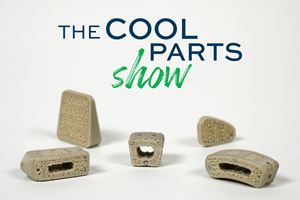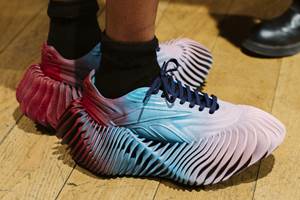Research Indicates Accelerated Industry Growth Through Emerging Applications
Survey of more than 700 members of the global engineering community along with key market data identify the current and future state of additive manufacturing.
Share
Printing production-run volumes of parts is becoming an increasingly viable solution. Source: Protolabs
Protolabs’ newly published 3D Printing Trend Report provides a snapshot of the additive manufacturing (AM) industry and highlights emerging trends as applications for 3D printing’s continued growth. Through key market data and a survey of more than 700 members of the global engineering community, Protolabs’ annual report depicts a healthy level of confidence in the 3D printing market driving more potential for production-level manufacturing as the technology’s uses expand beyond prototyping. In addition, micro and large-format applications continue to expand.
Key findings include:
- 3D printing market growing 10.5% faster than predicted
- 2024 market size estimated at $28.1 billion
- Market to reach $57.1 billion by the end of 2028
- 70% of businesses printed more parts in 2023 than in 2022
- 77% reported the medical sector has most potential for impact
3D Printing’s Potential for Production
The data shows that 3D printing is steadily moving beyond prototyping toward production applications. Protolabs’ annual report reveals a steady growth in production-run volumes. Respondents who said they printed more than 10 parts rose from 36% in 2020 to 49% in 2021 and to 76% in 2023.
The mindset around additive and production is slowly changing as well. “Production volume and scale” was named by 45% of survey respondents as a factor for choosing other manufacturing methods over 3D printing — down from 47% in the previous year.
Innovative Materials on the Rise
Moving forward, the report found the expansion of available materials and related technologies will play a vital role in shaping future use cases. For example, nearly a third of respondents reported multimaterial printing will have the biggest impact on 3D printing growth, second only to hybrid manufacturing, which combines additive technology with traditional services.
Industry experts agree that highly specialized materials designed for 3D printing applications are coming to market, providing even more scope for innovation.
“Companies are designing blends actually tailored for 3D printing,” says Adam Hecht from 3DP design studio DIVE. “They’re creating a lot of materials that are geared for very specific applications within 3D printing, whether that’s conventional thermoplastics that have been reengineered for 3D printing, or resins that aren’t just for prototyping, but for very specialized, high-temperature, high-elasticity types of applications.”
Where AI is Taking the Technology
As the enthusiasm for artificial intelligence (AI) permeates almost every sector, 3D printing is no exception. Protolabs’ report reveals the promise of an AI-disrupted industry has yet to be fully realized; however, smart printers are getting smarter and improving the user experience. Nearly a third of respondents identified automated print tuning as the top impact from AI, followed by nonplanar fused deposition modelling (FDM) printing through improved slicer software (25%). Design for additive manufacturing will also benefit from AI innovations — think topology optimization, multiphysics process simulation and AI-generated CAD.
To find out more about the status of additive manufacturing — broken down by industry and region — and where 3D printing is heading next, download the full report.
Protolabs works with customers globally as an AM partner, utilizing plastic and metal 3D printing technologies to serve customer needs for prototype and production parts.
Related Content
FDA-Approved Spine Implant Made with PEEK: The Cool Parts Show #63
Curiteva now manufactures these cervical spine implants using an unusual 3D printing method: fused strand deposition. Learn how the process works and why it’s a good pairing with PEEK in this episode of The Cool Parts Show.
Read MoreConcept Sneaker Boasts One-Piece 3D Printed TPU Construction
The Reebok x Botter Concept Sneaker Engineered by HP premiered at Paris Fashion Week, hinting at manufacturing possibilities for the future of footwear.
Read MoreActivArmor Casts and Splints Are Shifting to Point-of-Care 3D Printing
ActivArmor offers individualized, 3D printed casts and splints for various diagnoses. The company is in the process of shifting to point-of-care printing and aims to promote positive healing outcomes and improved hygienics with customized support devices.
Read MoreUnderstanding PEKK and PEEK for 3D Printing: The Cool Parts Show Bonus
Both materials offer properties desirable for medical implants, among other applications. In this bonus episode, hear more from Oxford Performance Materials and Curiteva about how these companies are applying PEKK and PEEK, respectively.
Read MoreRead Next
Bike Manufacturer Uses Additive Manufacturing to Create Lighter, More Complex, Customized Parts
Titanium bike frame manufacturer Hanglun Technology mixes precision casting with 3D printing to create bikes that offer increased speed and reduced turbulence during long-distance rides, offering a smoother, faster and more efficient cycling experience.
Read More3D Printed Polymer EOAT Increases Safety of Cobots
Contract manufacturer Anubis 3D applies polymer 3D printing processes to manufacture cobot tooling that is lightweight, smooth and safer for human interaction.
Read MoreProfilometry-Based Indentation Plastometry (PIP) as an Alternative to Standard Tensile Testing
UK-based Plastometrex offers a benchtop testing device utilizing PIP to quickly and easily analyze the yield strength, tensile strength and uniform elongation of samples and even printed parts. The solution is particularly useful for additive manufacturing.
Read More





















